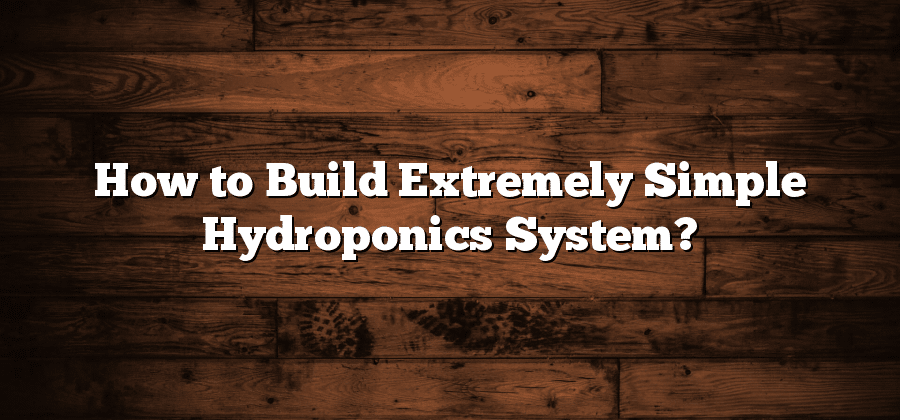Understanding the Basics of Hydroponics Systems
Hydroponics systems are a modern method of cultivating plants in water, without the need for soil. This innovative approach to gardening offers numerous benefits, such as increased control over nutrient intake, water conservation, and maximized use of space. Rather than relying on traditional soil cultivation, hydroponics systems utilize a nutrient-rich water solution that provides plants with all the necessary elements to thrive. By eliminating the reliance on soil and allowing direct access to nutrients, hydroponics systems allow for faster growth and higher yields.+
One of the key components of a hydroponics system is the growing medium. Unlike traditional gardening where soil provides support and nutrient supply, hydroponics systems use different materials as a substitute for soil. These growing mediums act as a support structure for the plants and help in water retention while allowing the roots to access the nutrient solution. Commonly used growing mediums include perlite, rockwool, coconut coir, and vermiculite. The choice of a growing medium depends on various factors, such as the type of plants being grown, the system being used, and personal preference.
Selecting the Right Container for Your Hydroponics System
When it comes to setting up your hydroponics system, one of the most crucial decisions you’ll need to make is selecting the right container. The container you choose will not only serve as the home for your plants but also play a significant role in the overall efficiency and success of your hydroponics setup.
First and foremost, it’s essential to opt for a container that is durable and waterproof. Since hydroponic systems rely on a water-based medium, you want to ensure that your container can withstand constant exposure to moisture without deteriorating or leaking. Look for containers made from materials such as plastic, fiberglass, or PVC, as these are known for their resistance to water damage.
Moreover, consider the size of the container based on the number of plants you intend to grow. If you’re just starting and have limited space, smaller containers may be more suitable. On the other hand, if you have a larger hydroponics setup or plan to expand your garden in the future, investing in bigger containers will allow your plants to have ample room for growth. Remember that overcrowded containers can impede root development and negatively affect the overall health of your plants.
Choosing the Ideal Growing Medium for Hydroponics
When it comes to hydroponics, the growing medium plays a crucial role in providing the necessary support and nutrients to the plants. Unlike traditional soil-based gardening, hydroponics relies on a different medium to anchor the roots and supply nutrients directly to them. The ideal growing medium for hydroponics should have certain characteristics to promote healthy plant growth and maximize yields.
One commonly used growing medium in hydroponics is perlite. Perlite is a lightweight, volcanic rock that has been heated and expanded. It is highly porous, allowing for proper drainage and aeration of the roots. Additionally, perlite does not retain excess water, preventing the risk of overwatering and root rot. Another popular choice for a growing medium is coconut coir. Made from the fibrous husk of coconut shells, coconut coir is a renewable and sustainable option. It has excellent water retention capabilities while still providing good drainage. Coconut coir also has high cation exchange capacity, meaning it can hold onto and release nutrients as needed by the plants.
Selecting the Appropriate Nutrient Solution for Your Plants
Choosing the right nutrient solution for your hydroponic plants is crucial for their overall growth and productivity. The nutrient solution acts as a replacement for the soil, providing essential elements and minerals necessary for the plants’ development. To select the appropriate nutrient solution, you need to consider several factors.
Firstly, it is essential to understand the nutrient requirements of the plants you are growing. Different plants have different nutritional needs, so it is crucial to do some research to determine the ideal nutrient composition for your specific plants. Most nutrient solutions contain a combination of macronutrients, such as nitrogen, phosphorus, and potassium, as well as micronutrients like iron, manganese, and zinc. However, the proportions of these nutrients can vary depending on the type of plant you are growing. Therefore, it is essential to consult expert resources or seek advice from experienced hydroponic gardeners to ensure you are providing the correct nutrient blend for your plants.
Building the Reservoir for Your Hydroponics System
Once you have selected the appropriate container and growing medium for your hydroponics system, it’s time to focus on building the reservoir. The reservoir is where the nutrient solution is stored and distributed to your plants. It is essential to have a well-designed reservoir to ensure the proper functioning of your hydroponics system.
When building the reservoir, one important factor to consider is its size. The size of the reservoir will depend on the number of plants you intend to grow and the system you are using. Keep in mind that the reservoir should be large enough to hold an adequate amount of nutrient solution, but not so large that it becomes difficult to maintain or monitor. Additionally, make sure the reservoir is made of a material that is resistant to corrosion and can withstand constant exposure to water and nutrient solutions. This will not only ensure the longevity of your reservoir but also prevent any potential contamination of the nutrient solution.






